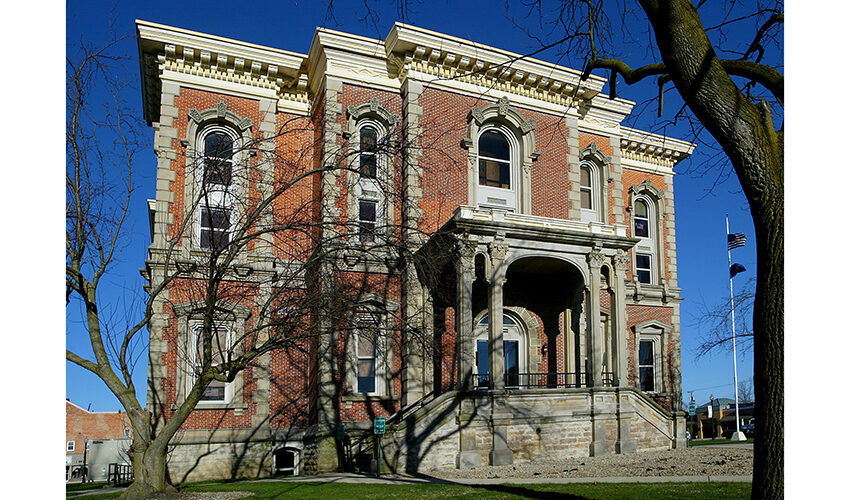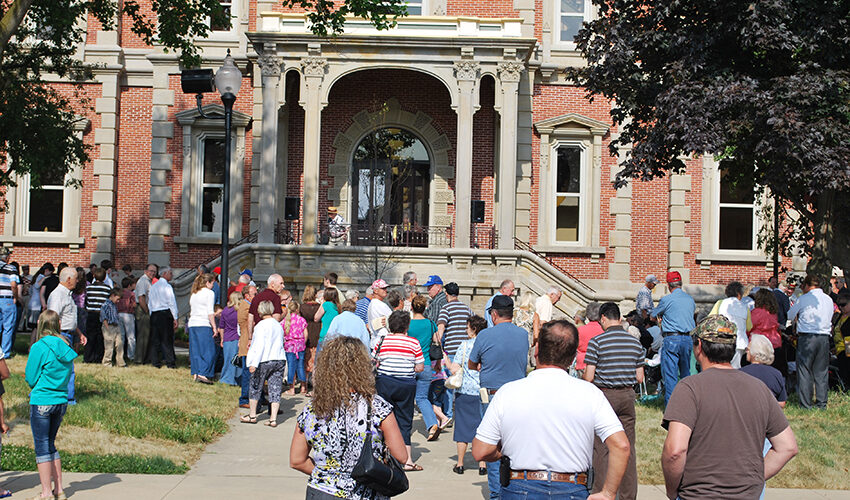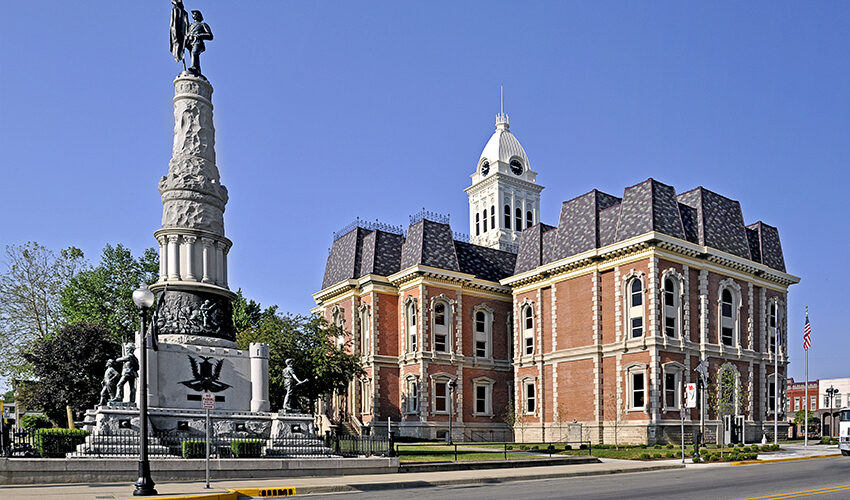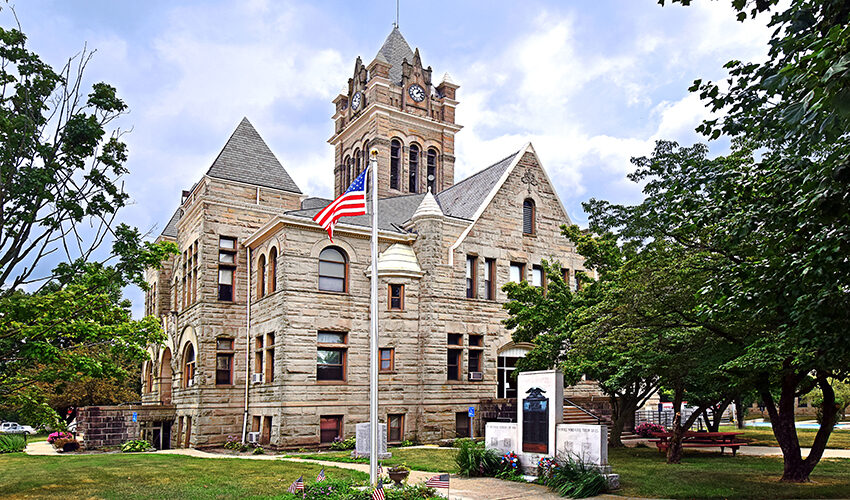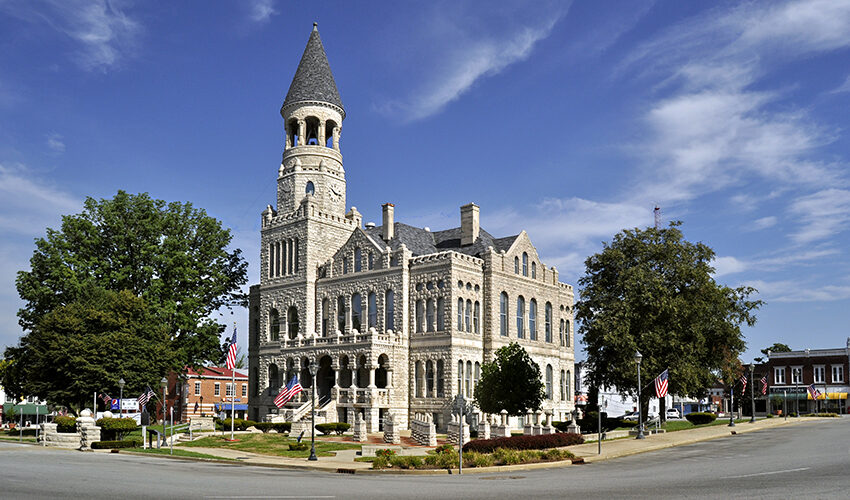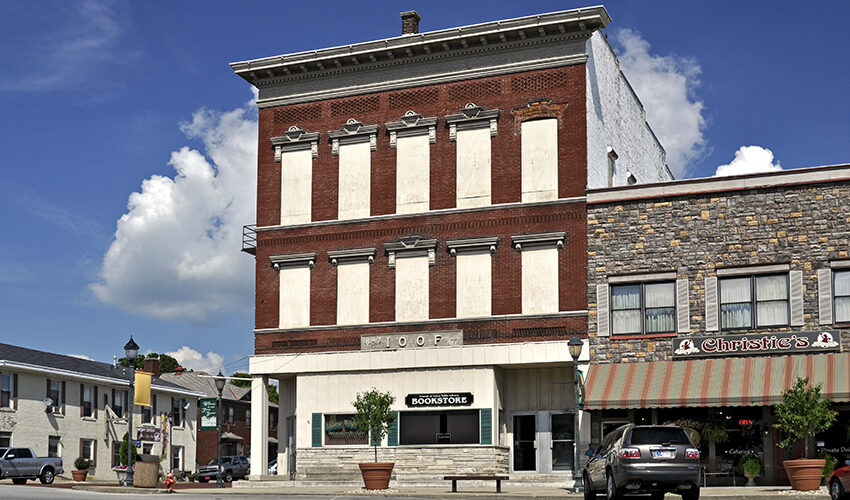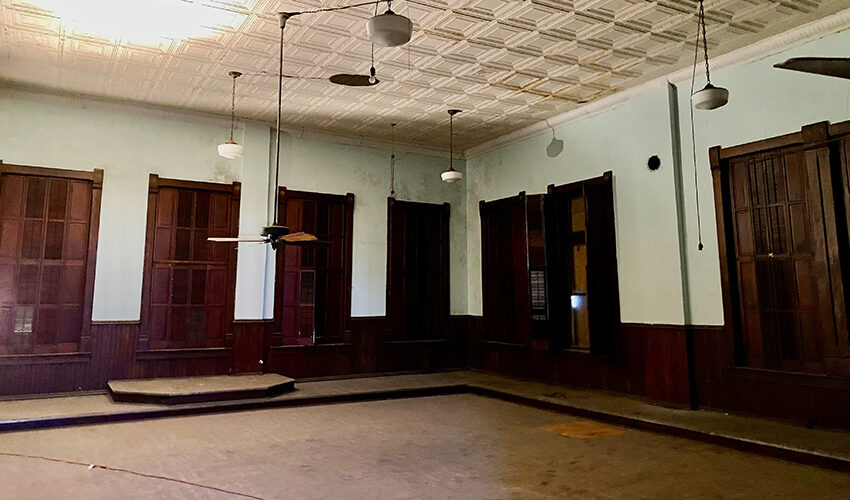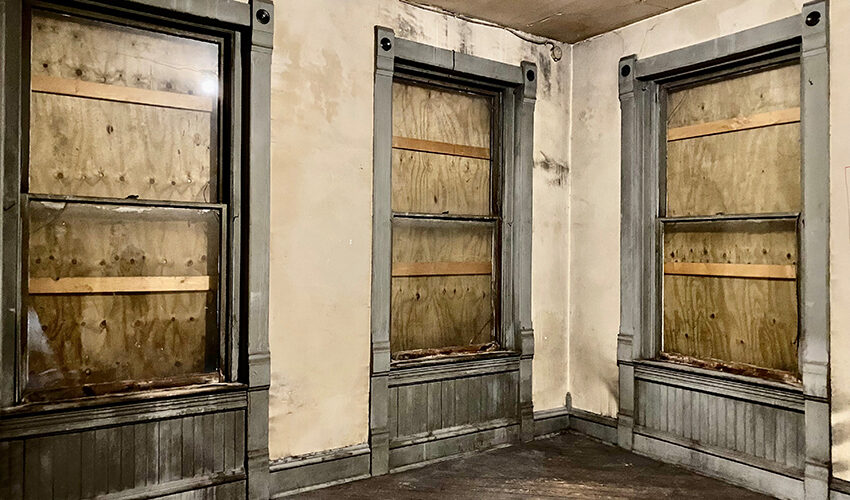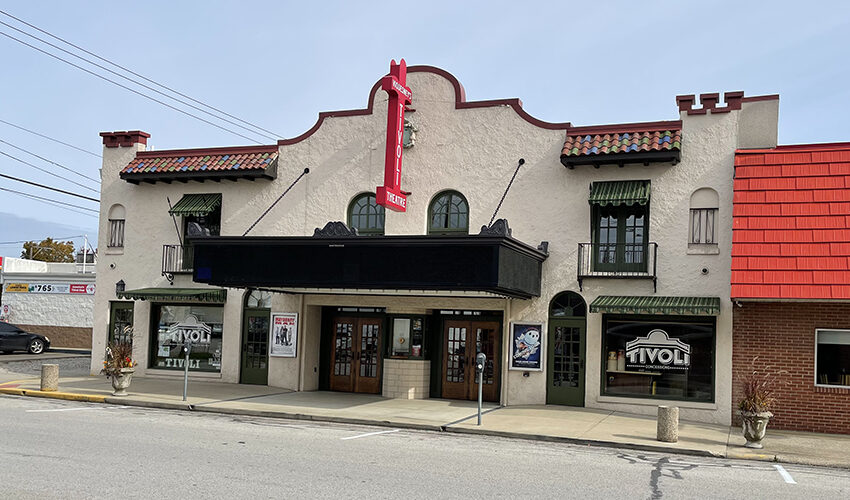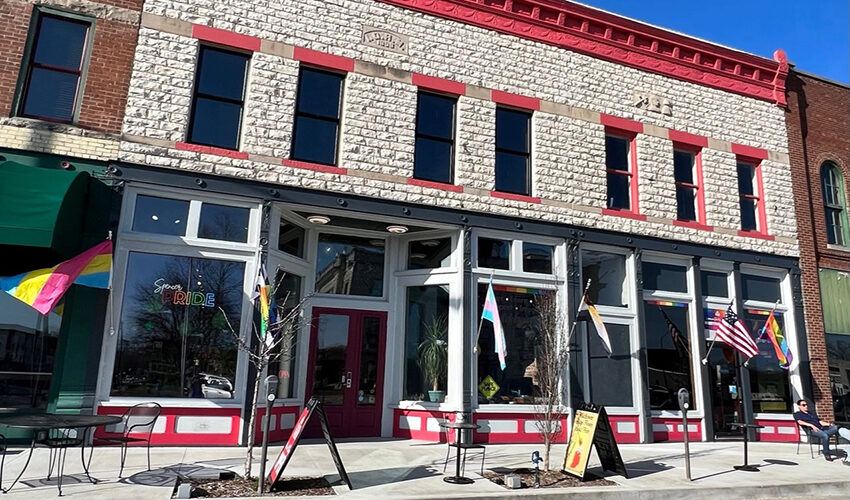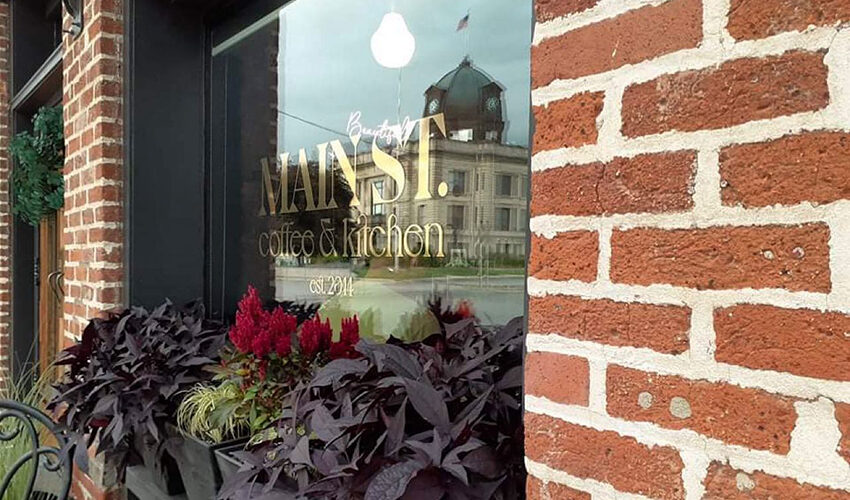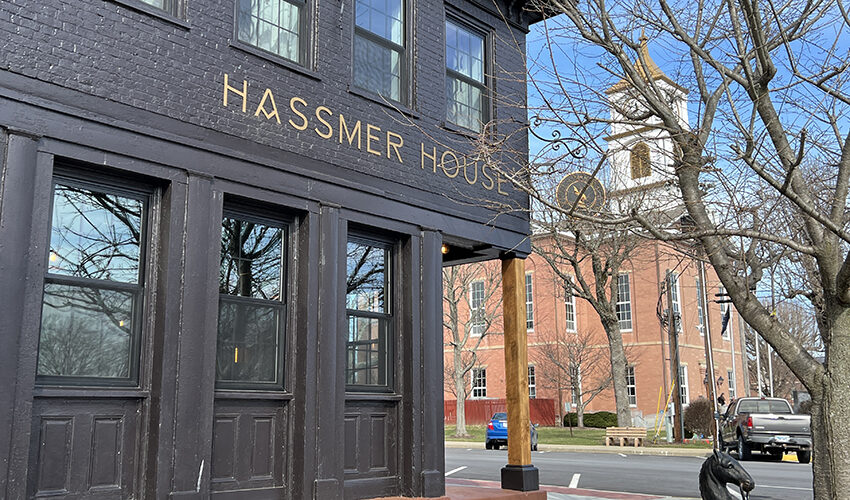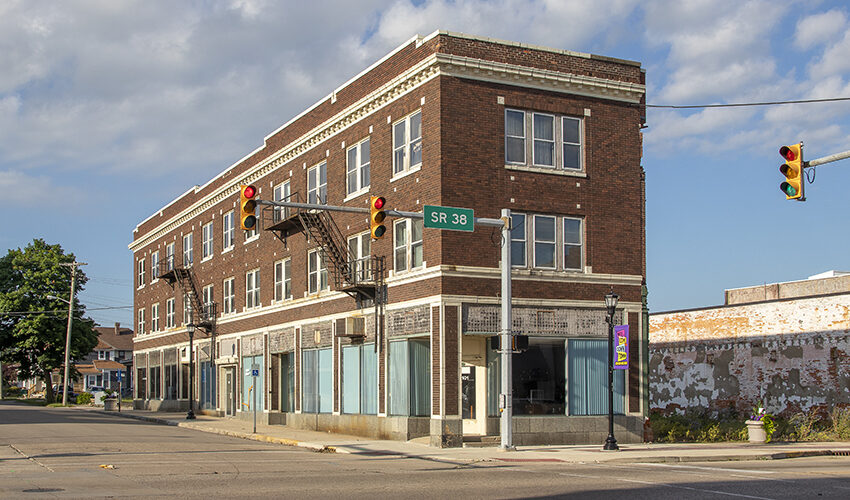NEWS
Courthouse Squares at the Center of Downtown Revitalization
Historic courthouses serve as icons of community pride and identity that can be catalysts for investment in surrounding squares.
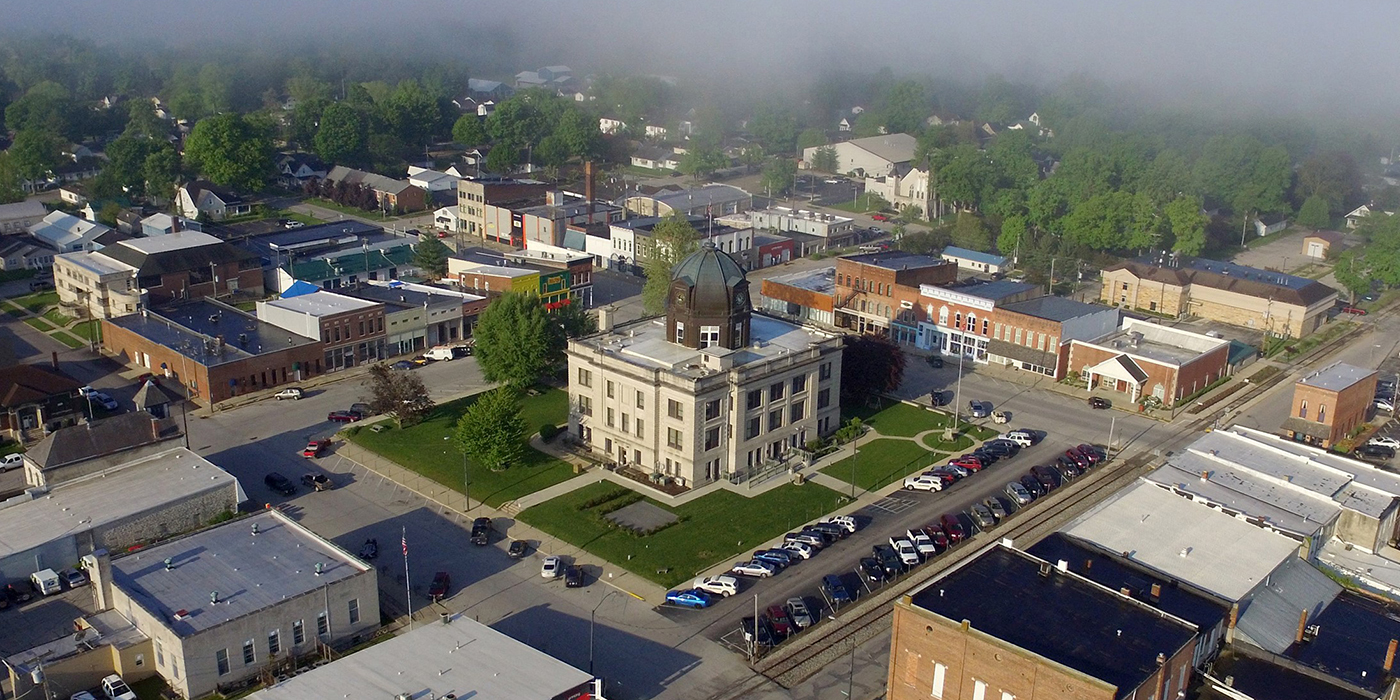
Seat of Power
In downtowns across Indiana, historic courthouses rise physically and symbolically as icons of community pride and identity. But their outsized status does not guarantee immunity from threats. Like other historic landmarks, these monumental buildings come with challenges, including space constraints, accessibility concerns, the cost of upgrading systems and security, and the expense of ongoing maintenance—a particular burden in small towns with a limited tax base to fund repairs.
Several communities have successfully found ways to overcome the challenges; some have even leveraged investment in their courthouses as a stimulus for additional downtown development. Others are still looking for solutions.
Contempt of Court
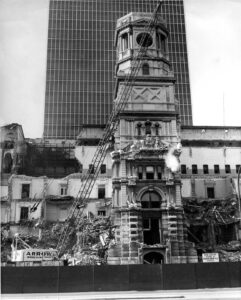
Silhouetted against the backdrop of the succeding City-County Building, the monumental carved stone tower is battered into dust by the weight of the wrecking ball. The magnificent columns on the structure were solid turned spindles of polished granite.The lighting fixtures, wood carvings, ornamental plaster work, and hand-painted murals in the building were the work of skilled craftsmen and accomplished artists.
In 1962, crowds gathered to watch wrecking balls smash the 1876 Marion County Courthouse in Indianapolis. Claiming that the old courthouse was too small for the newly consolidated city-county government, officials opted to demolish the grand Second Empire-style landmark and replace it with a modern skyscraper. Photos of the wreckage—still hard to look at—became a rallying cry for Indianapolis’s just emerging historic preservation community, including the recently formed Historic Landmarks Foundation of Indiana. In spite of the dismay generated by its destruction, the Marion County Courthouse wasn’t an outlier. From 1957 to 1979, eight nineteenth-century Indiana courthouses were razed for new buildings.
By the time Randolph County Commissioners voted to demolish its 1877 courthouse in 2005, preservation advocates were more experienced. The community jumped to the landmark’s defense, collecting thousands of petition signatures, packing commission meetings, and holding rallies on the courthouse square. Members of the Farmland Bridge Club, ranging in age from 77 to 94, drew publicity and money for the cause as the Courthouse Girls, posing for a “nude” calendar with strategically placed miniature models of the courthouse. Eventually commissioners reversed their decision, choosing instead to invest in the courthouse, even reconstructing its long-lost tower.
To head off similar threats in other counties, Indiana Landmarks created a task force to investigate protective legislation. With support from lawmakers, we convinced the Indiana General Assembly to create the Indiana Courthouse Preservation Advisory Commission, which studied the condition of Indiana’s historic courthouses and surveyed elected officials and county employees about rehabilitation needs. The group submitted a report summarizing its findings in 2011, including notes on funding resources for preservation.
After such high-profile advocacy in defense of historic courthouses, a 2018 plan by commissioners to demolish Pulaski County’s 1894 Romanesque Revival courthouse came as a shock. Indiana Landmarks added the building to its 10 Most Endangered list and hired Indianapolis-based Rowland Design to review the county’s initial plans, proving that demolition would be far more costly than moving forward with renovation. Though the commissioners reversed their initial decision and moved forward with a bond to expand a modern Justice Center, several officials expressed skepticism about pursuing additional funding to renovate the historic courthouse. At the close of 2021, the county council and county commissioners voted to support the courthouse’s renovation 4-3, planning to decide on how to fund the project in the coming months. “We’re cautiously optimistic,” says Todd Zeiger, director of Indiana Landmarks’ Northern Regional Office. “But we won’t be fully at ease until we see construction underway on the courthouse.”
Hip to be Square
Traditionally, courthouses served as the social and economic hearts of downtowns, pumping energy into the surrounding area. In more recent years, as interstates and modern retail trends pull business away from downtown districts, some communities have focused attention on their historic courthouses as catalysts for revitalization.
Bloomington’s courthouse square is a thriving city core centered around its 1908 Beaux Arts-style courthouse, saved from demolition and restored inside and out in the 1980s. Listed in the National Register of Historic Places in 1990, the area gained added protection in 2015 when it became a local historic district, a designation that helps protect a mix of historic buildings dating from the 1840s to the 1970s. Today, dozens of local businesses—restaurants, boutiques, art galleries, nail salons and spas, and other stores—populate the blocks surrounding the courthouse.
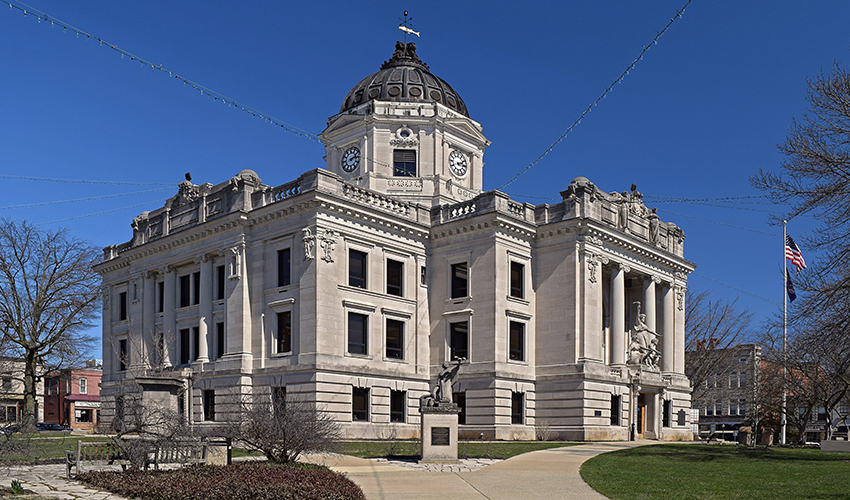
Monroe County Courthouse, Bloomington (PHOTO: Lee Lewellen)
Preserving historic courthouses can be a powerful spark for broader revitalization by encouraging people to invest in surrounding buildings. In Salem, the soaring tower of the 1888 Washington County Courthouse provides a visual focal point for miles around, but it was a feature in danger in 2016, weakened by ill-conceived repairs following a lightning strike in 1934. Indiana Landmarks named the courthouse to its 10 Most Endangered list to draw attention to the building’s plight, galvanizing county officials to assess the courthouse and make nearly $2 million in repairs.
The courthouse’s renewal encouraged attorney Lisa Fleming in 2020 to buy the 1897 International Order of Odd Fellows Building on a corner of the square for her law office. Spanning three stories with a full basement, the sturdy building’s tall ceilings, maple flooring, and virtually untouched third-floor lodge hall drew Fleming. “When I got in the building, I had the feeling of stepping back in time,” says Fleming.
She received a $100,000 historic renovation grant from the Indiana Office of Community and Rural Affairs (OCRA) to aid exterior renovation, including tuckpointing brick, installing a new storefront, and repairing wood windows. In addition to her law office, Fleming eventually envisions installing a general store on the first floor, and perhaps an art gallery and event space above, with a tavern in the basement. With investment in and beautification of the square, development of nearby trails, and the area’s low cost of living, Fleming predicts Salem will become an even more attractive place to live and work. “I have a vision for 25 or 30 years down the road,” she says. “I think this is a wonderful place to be, a wonderful place to have a business.”
The restoration of such anchor buildings can be like a pebble in the pond, starting a ripple of reinvestment around the square. In Spencer, Indiana Landmarks affiliate Owen County Preservations led a years-long campaign to save the 1928 Mission Revival-style Tivoli Theatre, reopened in 2013 as a first-run movie theater after Cook Group, Inc., funded its restoration. The revived landmark continues to draw visitors and foot traffic back downtown. “It brings in hundreds of people every weekend for a universally loved pastime and really helped build confidence of others in the community,” says Jonathan Balash, director of Spencer Pride.
Since the theater’s rejuvenation, the small town—population 2,230—has seen the opening of Civilian Brewing Corps, gourmet fudge shop Diamond K Sweets, Jit’s Thai Bistro, Main Street Coffee, and The Dragonfly Gallery, a gift shop and art gallery. Spencer Main Street received a $500,000 Main Street Revitalization grant from OCRA, that, matched by the Town of Spencer and private donations, resulted in over $1 million in beautification efforts throughout downtown, including new sidewalks and curbs, benches, lighting, and flowers and trees.
Spencer Pride saw an opportunity to do its part by rehabilitating the 1898 Improved Order of Redmen Building for use as its CommUnity Center, an LGBTQ+ community center. Indiana Landmarks supplied an Efroymson Family Endangered Places Grant to help the group assess the historic structure’s rehabilitation priorities, including replacing the roof, making the windows more energy efficient, and improving the front façade. Opened in 2016, the building houses a retail shop, health and wellness services and classes, the Gathering Place—an informal hangout space—and a meeting room available for free to local LGBTQ+ affirming non-profits. Spencer Pride is continuing its rehabilitation work on the second floor. “One of the things we’re very mindful of is how people are using our space and the downtown itself,” adds Balash. “We all work together as individuals and organizations in our community to create welcoming spaces for people to come explore Spencer.”
Nearby, Brianne and Josh Hogan purchased Spencer’s Languel Building in 2013 as a home for their family of nine. Their business, Main Street Coffee, started out almost by accident. They had fixed up the front of the building as a pop-up shop to sell Brianne’s handcrafted goods at a local festival, offering coffee for sale as well. “We put up a handwritten sign, ‘Main Street Gifts and Coffee,’” recalls Josh Hogan. “It was almost tongue in cheek.”
Their surprising success inspired the Hogans to start selling coffee and locally baked goods on a regular basis, first on weekends, then Wednesdays through Saturdays. Eventually, Josh quit his construction job to run the business and reconfigure their historic commercial building to add seating, leading to two expansions. The most recent remodel debuted in August 2021, increasing seating capacity to 40. “Growing up, I always loved downtown, but it was kind of fading in the ’80s,” says Josh. “We’ve been super excited to be part of its revitalization.”
Business Sense
In other communities, efforts to revive courthouse squares are in still early stages. With vintage character and prime location, historic commercial buildings offer unique potential as locations for new business.
In Versailles, the Hassmer Hotel has been a fixture on courthouse square for almost 200 years. Since its construction c.1830, the two-story structure has served as a saloon, restaurant, hotel, and even a temporary jail. The building had been vacant for more than a dozen years by the time Rachael and David VanArtsdalen saw it in 2020, but they were able to look past the dingy aluminum siding and dated interior to embrace the place’s potential. The couple rehabbed the landmark as the Hassmer House Tavern & Inn, a community-based restaurant featuring ingredients sourced from local farms and purveyors. They adapted the second floor as an Airbnb suite, featuring great views of the c.1860 Ripley County Courthouse across the street. Their work builds on other downtown rehabilitation efforts underway by local Holly Wehr, who is adapting two historic buildings on the square as a boutique hotel and event center.
We hope for similar positive action in New Castle where, for years, county officials discussed demolishing New Castle’s Courthouse Annex and using the site for parking, a threat that landed the building on Indiana Landmarks’ 10 Most Endangered List in 2021. Constructed at the turn of the twentieth century, the Courthouse Annex stretches along the entire 100 block of 12th Street—a three-story Classical Revival edifice with terra cotta details and large windows that reflect the 1869 Henry County Courthouse across the street. Prompted by the increased attention and renewed calls for preservation, Henry County Commissioners agreed this spring to accept rehabilitation proposals for the annex, a step that could lead to its redevelopment and spark additional investment in the downtown district.
This article originally appeared in the May/June 2022 issue of Indiana Preservation, Indiana Landmarks’ member magazine.
Stay up to date on the latest news, stories, and events from Indiana Landmarks, around the state or in your area.

